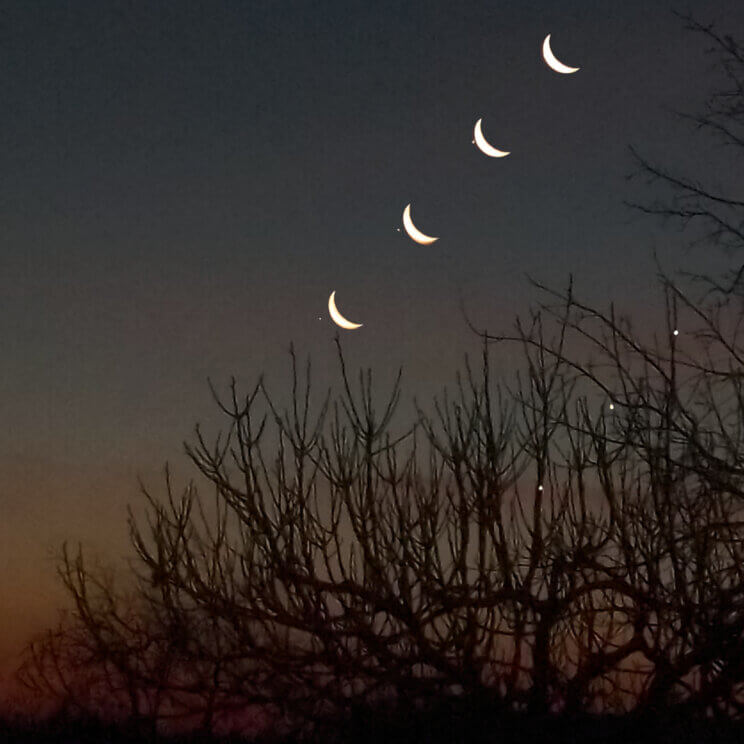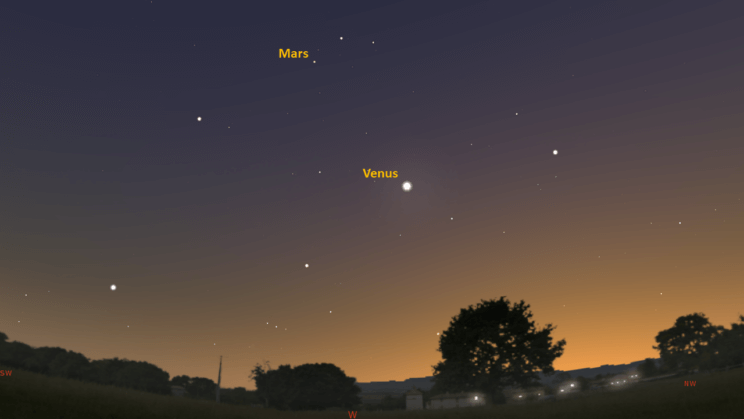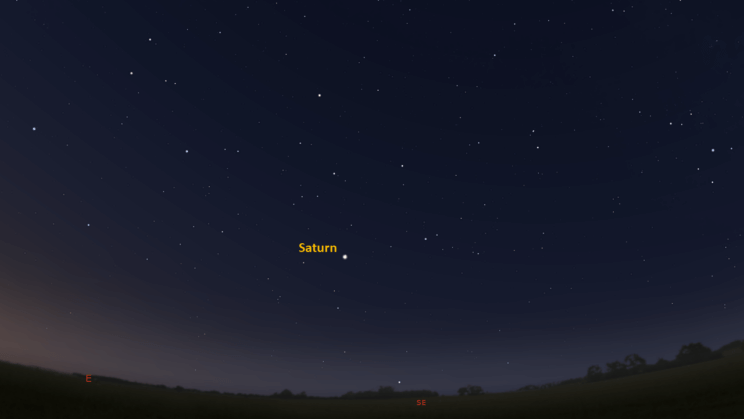This is the Saint Louis Science Center’s NIGHT SKY UPDATE for the week of Friday, May 5, 2023.
Information updated weekly or as needed.
Times given as local St. Louis time which is Central Daylight Time (CDT). For definitions of terminology used in the night sky update, click the highlighted text. If relying on times posted in Universal Time (UT), St. louis is -5 hours when CDT.
Public Telescope Viewings
As part of the Saint Louis Science Center’s First Fridays, weather permitting, the St. Louis Astronomical Society and the Science Center will set up a number of telescopes outdoors and be on-hand to answer your questions. Telescope viewing begins once it is dark. Regardless of the weather on June 2, join us indoors in our planetarium theater for “The Sky Tonight”. Showtime is at 7 p.m.
Observing Highlight of the Week

Occultation of Jupiter seen from Italy on July 15,2012. Image Credit: Giuseppe Donatiello.
Every month the Moon passes by each of the planets as it appears to shift through the zodiac constellations. In a few weeks, the Moon will start another lunation. As it does this, we will eventually find the Moon passing by Venus and Mars in the west. The Moon will be near Venus and Mars in the west after sunset from May 22 to May 24.
After May 5, 2023, the Moon starts its waning phases resulting in later rise times each night. As it progresses into the waning crescent phases near the end of this week, the Moon will begin to approach the planets visible in the east before sunrise.
On May 13, 2023, The Moon and Saturn will reach conjunction. If you look southeast after 5:00 a.m. you will find the Moon and Saturn about 3° apart. Conjunctions are when astronomical objects temporarily share the same right ascension. This is a common event to see as the Moon will pass by Saturn each month.
On May 17, 2023, most viewers around the world will find Jupiter near a thin wanning crescent moon before sunrise. However, for those in North America, Greenland, Iceland, Scotland and Scandinavia, Jupiter will be occulted by the Moon. Occultations occur as one astronomical object passes in front of another obscuring it from view. On May 17, Jupiter will disappear behind the Moon at 6:30 a.m. CDT and reappear again at 7:34 a.m. CDT. There is one major problem with this, it occurs after sunrise. Anytime the Sun is above the horizon we must take precautions to ensure we do not look at the Sun. This is important to remember because a telescope will be required to spot Jupiter and the Moon. Unless using proper safe solar filters, you should never look at the sun in any way.
Daytime views of the naked eye planets are possible if you know exactly where to look. A properly aligned mount that allows you to use right ascension and declination coordinates will make it possible to find Jupiter in the daytime. Another option is if you have access to a go-to telescope mount. Before sunrise, target Saturn or something else already visible and once the Moon and Jupiter rise, move over to those. If you are using a telescope or binoculars to see the occultation, make sure you always know where the Sun is and avoid aiming those devices anywhere near the Sun. The Moon and Jupiter will only be 26° away from where the Sun is. I would not recommend attempting to view this event for those who are not experienced in daytime viewing of the planets.
Lastly, Venus and Mars will appear closer together each night until July 1, 2023, when Mars will appear about 3° east of Venus. This pairing will continue to be a fine target in the west about 30 minutes after sunset until Venus’s motion starts to outpace the motion of Mars. Later in July, the bright star Regulus will appear near Mars on July 9, eventually appearing between Mars and Venus from July 11 to July 16.
The Sun and Moon

The Moon as seen from the International Space Station, on July 31, 2011.
Credit: NASA
Sunrise is at 5:59 a.m. on Friday, May 5 and sunset is at 7:56 p.m. providing us with about 14 hours of daylight. Even after sunset, light from the Sun will dimly illuminate our sky for roughly 1 hour and 45 minutes. This period is called twilight, which ends around 9:39 p.m. this week. For those with a sundial, local noon occurs around 12:57 p.m. this week.
| Day | Sunrise | Sunset | ||||||||||
|---|---|---|---|---|---|---|---|---|---|---|---|---|
| 5-May | 5:59 a.m. | 7:56 p.m. | ||||||||||
| 6-May | 5:58 a.m. | 7:57 p.m. | ||||||||||
| 7-May | 5:57 a.m. | 7:58 p.m. | ||||||||||
| 8-May | 5:56 a.m. | 7:59 p.m. | ||||||||||
| 9-May | 5:55 a.m. | 8:00 p.m. | ||||||||||
| 10-May | 5:54 a.m. | 8:01 p.m. | ||||||||||
| 11-May | 5:53 a.m. | 8:02 p.m. | ||||||||||
| 12-May | 5:52 a.m. | 8:03 p.m. | ||||||||||
| 13-May | 5:51 a.m. | 8:04 p.m. |
Moon
Moonrise for Friday, May 5 is at 8:16 p.m. and moonset occurs at 6:22 a.m. on the following day. Friday, May 5, the Moon will reach full moon. Last quarter moon occurs on May 12, 2023, at 9:28 a.m.
International Space Station (ISS) Observing

There are several visible passes of ISS from St. Louis for the week of May 5. They occur during morning and evening hours. The best passes for this week are listed below. Use the table below for information about these passes.
Catch ISS from St. Louis starting Friday, May 5
| Date | Starts | Max. altitude | Ends | |||||||
|---|---|---|---|---|---|---|---|---|---|---|
| Time | Alt. | Az. | Time | Alt. | Az. | Time | Alt. | Az. | ||
| 10 May | -3.2 | 5:16:33 | 10 | NW | 5:19:53 | 62 | NE | 5:23:12 | 10 | ESE |
| 12 May | -3.4 | 5:15:07 | 10 | WNW | 5:18:18 | 42 | SW | 5:21:28 | 10 | SSE |
| 12 May | -3.4 | 21:55:50 | 10 | WSW | 21:59:07 | 63 | NW | 22:02:27 | 10 | NE |
| 13 May | -3.9 | 4:25:44 | 10 | NW | 4:29:05 | 83 | SW | 4:32:25 | 10 | SE |
| 13 May | -3.9 | 21:06:29 | 10 | SW | 21:09:47 | 69 | SE | 21:13:06 | 10 | NE |
Magnitude (Mag): The Measure of brightness for a celestial object. The lower the value is, the brighter the object will be.
Altitude (Alt): The angle of a celestial object measured upwards from the observer’s horizon.
Azimuth (Az): The direction of a celestial object, measured clockwise from an observer’s location with north being 0°, east being 90°, south being 180° and west being 270°.
For information about ISS flyovers and other visible satellites, visit www.heavens-above.com
Detailed information regarding all unmanned exploration of our universe, missions past, present, and planned, can be found at Jet Propulsion Laboratories:
The Visible Planets

Looking west at 8:30 p.m. on May 7, 2023. Credit: Stellarium, EG

Looking Southeast at 5:00 a.m. on May 8, 2023. Credit: Stellarium, EG
This week, three naked eye planets will be visible. Venus and Mars are found in the west after sunset. Saturn is now visible in the southeast about 30 minutes before sunrise.
Venus
Venus is now well into its current evening apparition. Venus will be a bright target in the west after sunset until August 2023 when it approaches inferior conjunction. This week, look for Venus in the west about 20 minutes after sunset. Venus sets at 11:32 p.m.
Mars
Mars now rises before sunset, becoming visible once it is dark. Look for it high in the west about 30 minutes after sunset. Mars sets at 12:59 a.m.
Saturn
Saturn rises at 3:08 a.m. Start looking for Saturn about 30 minutes after it rises. If you have lots of trees or buildings, you may have to wait an hour or so after it rises before it will be visible. Saturn will be about 20° above the southeastern horizon by 5:00 a.m.
James S. McDonnell Planetarium
Night Sky Update: May 5-13, 2023






